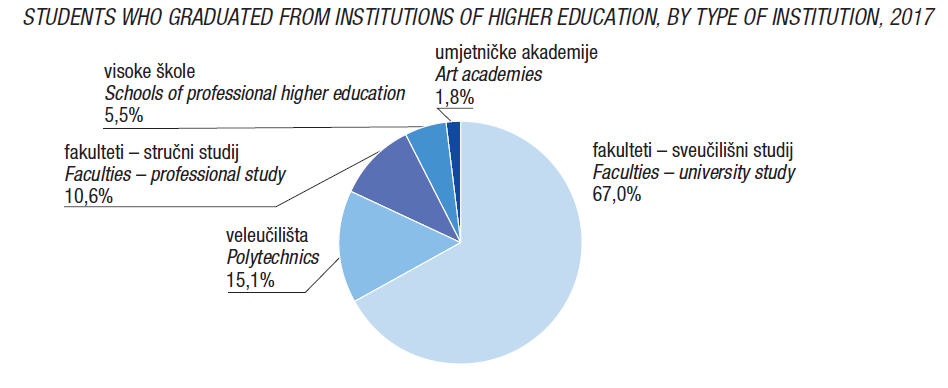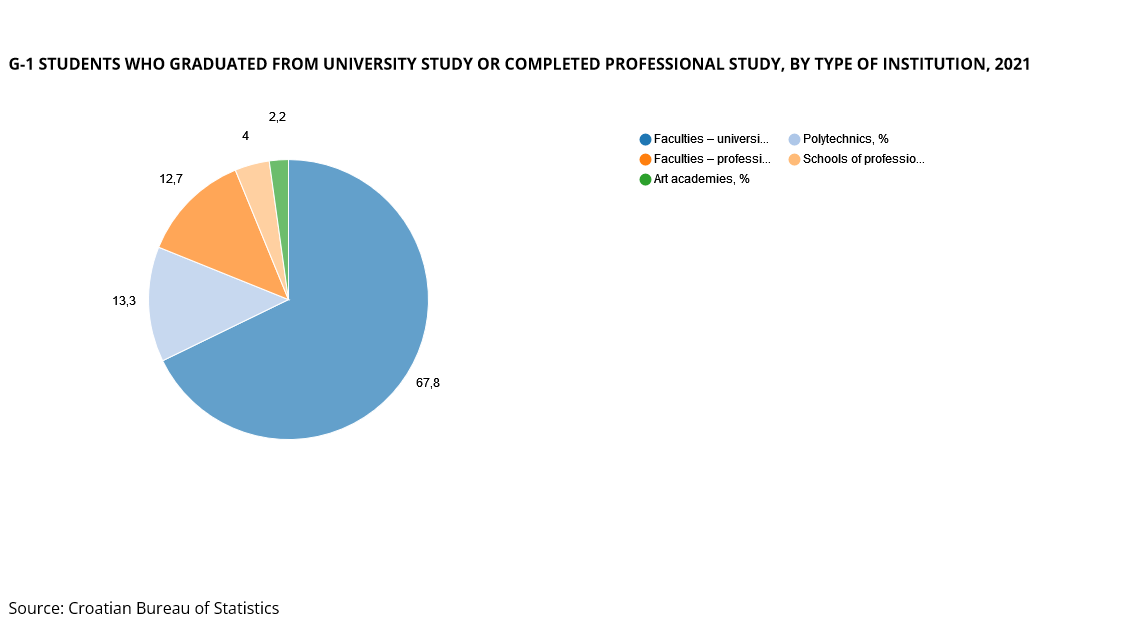5. Arts and cultural education
Croatia
Last update: June, 2023
The Ministry of Science and Education is the main body responsible for arts and cultural education and training in Croatia. In cooperates with the Ministry of Culture and Media on specific programmes and measures in this field. The Agency for Electronic Media and The Croatian Audiovisual Centre also develop and cooperate on programmes related to media and film literacy. The Agency for Teachers and Education is the body responsible also for professional development in this field and is a partner of the above-mentioned institutions in different programmes for schools.
Special arts education is carried out in primary and secondary schools of applied arts and design, music and dance schools. When attending primary music and or ballet schools, the pupils are obliged to concurrently attend regular primary school. According to the latest available data from the Croatian Bureau of Statistics (2022a), in 2020/2021 there were 131 dance and music primary schools with a total of 18 568 pupils and 2 559 teachers. In the same school year there were 53 secondary arts schools with a total number of 4 617 pupils and 2 040 teachers (Croatian Bureau of Statistics, 2022b).
At the university level arts education is carried in music, drama and fine arts academies whose number has remained stable throughout the years. In there were 6 art academies in Croatia – at the University of Zagreb - Academy of Dramatic Arts, Academy of Fine Arts, Academy of Music; at the University of Osijek - Arts Academy, and Academy of Dramatic Arts; Arts Academy in Split, and Academy of Applied Arts in Rijeka. The total number of students enrolled in academies in 2021/2022 was 2 748, with 941 academic staff, which shows an increase in the number of staff and an increase in the number of students in comparison to the previous four years according to the latest available data from the Croatian Bureau of Statistics (2022c). Programmes in cultural management were mainly covered through private education, as in Zagreb School of Management’s programme, and ‘Baltazar Krčelić’ School in Zaprešić. However, since the 2018 merger of the Academy of Arts in Osijek and the Department of Cultural Studies of the University of Josip Juraj Strossmayer in Osijek into Academy of Arts and Culture, the Academy offers Undergraduate courses in culture, media and management and Graduate courses in management of cultural and creative industries.
Arts and cultural education in Croatia has not been adequately addressed in cultural or educational policies and it has neither been defined nor sufficiently mapped as research by Žuvela (2016) notes. The programmes are developed sporadically by the particular cultural organisations and institutions but not as a part of overall strategic planning in this domain. The Programme "Backpack (full) of Culture / Ruksak (pun) kulture" was developed as a supplementary measure since 2012 by the Ministry of Culture and Media and in association with the Ministry of Science and Education, and brings artists and cultural events directly to kindergartens, primary and high schools. This measure can be seen as a step in the direction of arts and culture education policies, bridging also the policies for enhancing cultural participation (see chapter 6.1). However, it is a complementary measure while a more systemic approach is needed in this direction.
Last update: June, 2023
According to the National plan for primary schools, arts education is part of obligatory curricula during all eight years of primary school – 35 hours per year (special double hour sessions); music education is obligatory during all eight years of primary school – also 35 hours per year. Looking at the total number of hours of arts education, according to selected research data, this puts Croatia among European countries with the lowest number of hours dedicated to this field (Levačić, 2017), which prompts questions on the need for change in the curriculum related to the arts.
General, linguistic and classical secondary schools (gimnazija) have one hour per week of music education, and one hour of arts education throughout the four years of education, while natural science-mathematics secondary schools have one hour per week during the first two years of education. Special natural science schools have two hours of music education per week during the fourth year and two hours of artistic education per week during the third year of study. This creates significant differences in arts and cultural education between pupils of different types of schools and potential for their unequal experience in the cultural and artistic sector and creation of cultural habits. Special arts education is carried out at national level in schools of applied arts and design, music and dance schools that have particular curricula according to their specialisation. There are private arts schools that are open to the public and which have to have a programme according to the national regulations in this field.
In the last couple of years, a number of initiatives of high school teachers in the arts highlighted the low number of hours of arts education in the curriculum (e.g. activities of art teachers within NGO OPA). In addition, The Agency for Electronic Media (AEM) and The Croatian Audiovisual Centre (HAVC) stressed the need for development of more adequate media and film literacy programmes for both primary, but even more for secondary students and their teachers as well. Some changes have occurred in a fragmented manner - AEM has developed its project/website ‘Media Literacy’ while HAVC slowly develops and support the film literacy programmes (see chapters 3.5.3 and 5.4).
In 2013 the new programme "Backpack (full) of Culture / Ruksak (pun) kulture" was established with the aim of bringing artists and cultural events directly to kindergartens, primary and high schools as a part of additional activities. The proposed programmes should be in line with the national curricula for the suggested subjects, to complement the missing artistic and cultural content in the existing curricula. The internal evaluation showed that such programmes were necessary for kindergartens, primary and high schools, where the arts and cultural education programmes are not adequately present. The evaluation showed that this is especially relevant for those educational institutions that are in the areas with inadequate traffic and digital connectivity (e.g. the islands, mountain regions etc.) (Ministry of Culture, 2020). In 2018, a special pilot programme for the islands called ‘The Island Backpack’ was created that resulted in the execution of 43 programmes and workshops on a number of Croatian islands where more than 600 children participated, while another pilot project for children of the Croatian diaspora was also tested in selected countries (Ministry of Culture 2020) (see more details chapter 6.1).
Last update: June, 2023
The Bologna process brought a number of changes to the higher education system in Croatia that had an impact on arts education. A number of new art schools and art academies have been established; however, no research data on the impact of the changes is available. The number of arts academies (music, drama and fine arts) remains steady in the last decade, amounting to 6 art academies in four different cities in Croatia. At the University of Zagreb - Academy of Dramatic Arts, Academy of Fine Arts, and Academy of Music; at the University of Osijek - Academy of Arts and Culture; Arts Academy at the University of Split, and Academy of Applied Arts at the University of Rijeka.
According to the latest available data by the Central Bureau of Statistics, Figure 1 shows the percentage of students who graduate from art academies in comparison to other institutions of higher education in 2021.
Figure 1: Students who graduated from university study or completed professional study, by type of institution, 2017

Source: Statistical Yearbook 2018, (Croatian Bureau of Statistics 2019a: 493).
Figure 2: Students who graduated from university study or completed professional study, by type of institution, 2021
In comparison to 2017, the number shows an increase, as in 2017 there was 1,8% of students that graduated from the arts academies in Croatia, while in 2021 this percentage amounted to 2.2% as shown in the Figure 2.
Training and education programmes focused on heritage, culture and creativity in general are to be found through different programmes developed at other faculties in universities around Croatia – e.g. programmes in history of arts, museology, archaeology, literature, library science, cultural studies at faculties of humanities and social sciences at universities in Dubrovnik, Osijek, Pula, Rijeka, Split, Zadar, Zagreb; design and architecture at the Faculty of Architecture in Zagreb, fashion and textile design at the Faculty of Textile and Technology in Zagreb etc. Arts education programmes are specialised for those students that are studying to become art teachers in high schools, but no specific arts or culture education has been developed more generally.
Last update: June, 2023
Cities and municipalities finance programmes of local community cultural centres and public educational centres, which are the only venues for art and culture in many smaller cities. The network of these community cultural centres is fully decentralised and the level of their involvement in cultural life as well as their ability to organise and/or host cultural and artistic programmes varies greatly from one city to the other depending on their development level. The biggest network of community cultural centres exists in the City of Zagreb. New initiatives have been made to revitalise these centres, especially with the help of EU funds (see chapter 2.6).
The Ministry of Culture and Media and the cities financially support theatres for children, youth and puppet theatres, registered either as public institutions or private companies. Most of these theatres also have studios for young actors. A number of NGOs develop cultural education programmes for children and pupils, which are developed as a part of their regular programmes.
An important role in promoting participation in music for the younger population is played by the ‘Jeunesses Musicales Croatia’ (HGM), a member of the ‘Jeunesses Musicales International’. One of their programmes is ‘cultural card’, which facilitates young people (aged 14 to 30) to have discounts in theatres, museums, concerts etc. ‘Music in the Neighbourhoods’ is another programme that HGM runs in cooperation with the City of Zagreb, with the aim of introducing classical music to primary school children.
Croatian Audiovisual Centre (HAVC) continually supports programmes of film literacy that mainly consist of out-of-school activities while also being partner in the ‘Media literacy’ project of Agency for Electronic Media (AEM) and UNICEF.
Last update: June, 2023
A special two-week intensive summer programme in media culture "Dr. Ante Peterlić" has been organised by the Croatian Film Club's Association since 1999. It is oriented primarily to teachers at primary and secondary level, teachers in amateur audio-visual associations, but also to university lecturers and artists. The programme has been recognised by the Ministry of Science and Education as a programme of professional training in media culture for teachers and professors.
Through the public calls for international cultural cooperation, The Ministry of Culture and Media provides funding to cover the costs of travel at different professional training residencies and programmes abroad for artists and cultural workers. The Croatian Audiovisual Centre also provides support for travel to professional training and workshops for audiovisual workers through their yearly public call for complimentary activities. It also provides funding for such programmes to be organised in Croatia.
